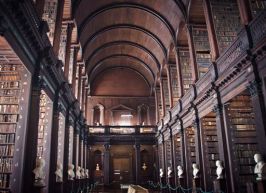
Peter and Wendy
- Children´s Literature
- Modernism
What It’s About
A Bittersweet Fantasy
Many people think they know J.M. Barrie’s classic tale of the mysterious boy, Peter Pan, who never grows up, and of the young girl, Wendy, who flies with him to the fantasy island of Neverland. But while the story of Peter Pan has been told time and again over the years, Peter and Wendy itself retains its ability to surprise the unwary reader. Despite its child-appropriate premise, a darkness lurks below the story’s surface – reflective of the sad real-life events which haunted Barrie himself. The novel’s sarcastic and opinionated narrator and its engagement of heady themes – including death, the power of imagination and the bitter sweetness of growing up – lend the text a depth and complexity that explain its resonance with adult readers since its 1911 publication. Both a celebration of childhood innocence and a warning allegory about its over-romanticization, Barrie’s creation simultaneously entertains the young, speaks to adults longing for a past golden era, and offers an ahead-of-its-time exploration of children’s emotional and moral development.
Summary
About the Author
J.M. Barrie (Sir James Matthew Barrie) was born on May 9, 1860, in Kirriemuir, Angus, Scotland. Barrie was the ninth of weaver David Barrie and homemaker Margaret Ogilvy’s ten children. He was close with his mother, an avid storyteller who had served as a surrogate maternal figure to her own siblings from the age of eight. The accidental death of Barrie’s older brother David when Barrie was six years old shattered Margaret’s spirits. Barrie tried dressing and acting like David to make her happy – but to no avail. He noted, however, how his mother found comfort in the belief that her son’s death meant he would stay a boy eternally — an idea which would inform a number of Barrie’s creative works. After graduating from Edinburgh University in 1882, Barrie worked at the Nottingham Journal as a staff writer. He began writing stories and novels in the late 1880s, many of which found popular success, and started composing plays in the early 1890s. Barrie’s third play, Walker, London (1892), introduced him to his future wife, actress Mary Ansell. They married on July 9, 1894, and though they remained wed until 1909, the union was purportedly unconsummated. At an 1897 dinner, Barrie met Sylvia Llewellyn Davies – the daughter of writer George du Maurier and the mother of George, John, Peter, Michael and Nicholas, whom Barrie had met in London’s Kensington Gardens. The fairy stories Barrie told Sylvia’s boys provided much of his inspiration for his most famous character, Peter Pan. Too, spending time with the Davies offered Barrie a chance to escape the confines of adulthood via imaginative play. After Sylvia’s death in 1910, Barrie, along with their nanny Mary Hodgson, assumed guardianship over the children. Barrie enjoyed many creative successes throughout the 1910s and 1920s, but tragedy struck his personal life again when his son George died in combat during World War I and Michael drowned in 1921. In 1929, Barrie gave the copyright of the Peter Pan works to a children’s hospital in London. He died of pneumonia on June 19, 1937, in London at age 77.












Comment on this summary